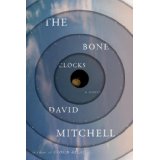SEPTEMBER 2014’S BEST BOOKS: 12 FICTION MUST-READS FOR YOUR IMAGINATION TO RUN WILD THIS FALL
 It’s fall—the start of a new school year and the time for a new reading list. Morgan Ribera’s got you covered with a list of a dozen books to be published during September that will keep you reading at least until winter break.
It’s fall—the start of a new school year and the time for a new reading list. Morgan Ribera’s got you covered with a list of a dozen books to be published during September that will keep you reading at least until winter break.
My own copy of one of the books on her list, The Bone Clocks by David Mitchell, just arrived yesterday. I’m also looking forward to another of her recommendations, The Secret Place by Tana French.
Celebrity writers pack the shelves as shops predict an autumn bonanza
The Guardian offers the U.K. outlook on this fall’s bonanza of novel publications.
A back-to-school reading list of classic literature
I expected a simple list of books from the folks at Oxford University Press, publisher of the Oxford World’s Classic series.
But they surprised me by using an “If you liked …, you might like …” Format. See what works of classic literature they recommend if you liked these books:
- Death of a Salesman by Arthur Miller
- Bury My Heart at Wounded Knee by Dee Brown
- Slaughterhouse-Five by Kurt Vonnegut
- The Lord of the Flies by William Golding
- The Handmaid’s Tale by Margaret Atwood
- One Hundred Years of Solitude by Gabriel Garcia Marquez
- The Grapes of Wrath by John Steinbeck
- One Flew Over the Cuckoo’s Nest by Ken Kesey
N.Y.C. Chancellor Pushes for Schools to Reinstate Independent-Reading Time
Education Week, the go-to source for information about teaching, reports that “Carmen Fariña, the new schools chancellor in New York City, is bringing the specifics of classroom reading instruction back into the public eye.”
At issue is the inclusion of independent reading, also known as sustained silent reading (SSR), in the school day. Writer Liana Heitin here reports that there has been little research into and little media attention on the question of whether SSR is effective in improving reading achievement since a 2000 report by a national panel. This article includes a short history of the issue and links to other online resources.
The Inspiring Stories Behind 15 Classic Novels
According to Jack London, “You can’t wait for inspiration, you have to go after it with a club.” London himself took the inspiration for The Call of the Wild (1903) from his time spent living in Canada and Alaska during the Klondike Gold Rush when high-quality sled dogs – like those that feature in the book – were in impossibly high demand. The stories and inspirations behind fifteen more of literature’s most memorable titles are explained here:
An interesting list, ranging from Tolstoy’s Anna Karenina to Daphne Du Maurier’s The Birds.
46 Brilliant Short Novels You Can Read In A Day
The end of the year is approaching. If you’re worried about meeting your GoodReads challenge, BuzzFeed has a list of books that weigh in at around 200 or fewer pages each that will allow you to pad your stats.
Cut it out, Ian McEwan: there are plenty of great long novels
Author Ian McEwan caused some consternation with a recent statement that “”very few really long novels earn their length.” In The Guardian Alison Flood points out:
It’s the Americans McEwan appears mainly to be blaming for this – our friends on the other side of the Atlantic “still pursue the notion of a great American novel and it has to be a real brick of an object”, he says …
Flood disagrees with McEwan and offers her list of “novels that might weigh as much as a brick, but to which I’d never take a blue pencil”:
- The Crimson Petal and the White by Michel Faber. 864 page
- The Blind Assassin by Margaret Atwood. 656 pages
- A Dance with Dragons by George RR Martin. 1016 pages
- The Stand by Stephen King. 1,200 pages
- Gone with the Wind by Margaret Mitchell, 992 pages
- The Bone Clocks by David Mitchell. 608 pages
Here are some I’d add to her list:
- Cloud Atlas by David Mitchell. 514 pages (paperback)
- Special Topics in Calamity Physics by Marisha Pessl. 514 pages
- Middlemarch by George Eliot. 794 pages (paperback)
- Ulysses by James Joyce. 732 pages (paperback)
- The Golden Notebook by Doris Lessing. 568 pages
- The Brothers K by David James Duncan. 645 pages (paperback)
- Underworld by Don DeLillo. 827 pages
I don’t mind a long book just because it’s long, but I do get annoyed by a book that’s longer than it needs to be. Moo by Jane Smiley is my illustration of this category. The hardcover weighted in at only 414 pages, but it should have been cut by about one-third.
